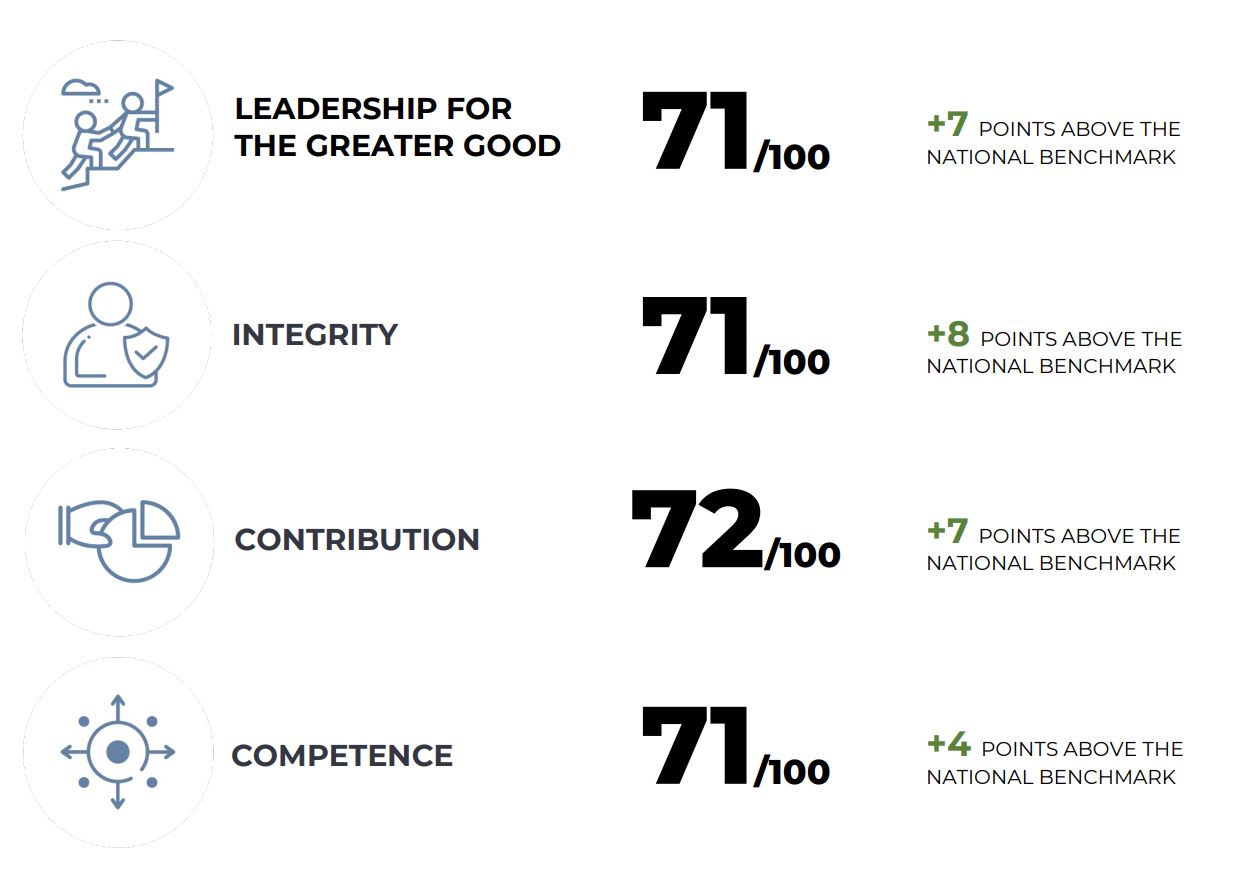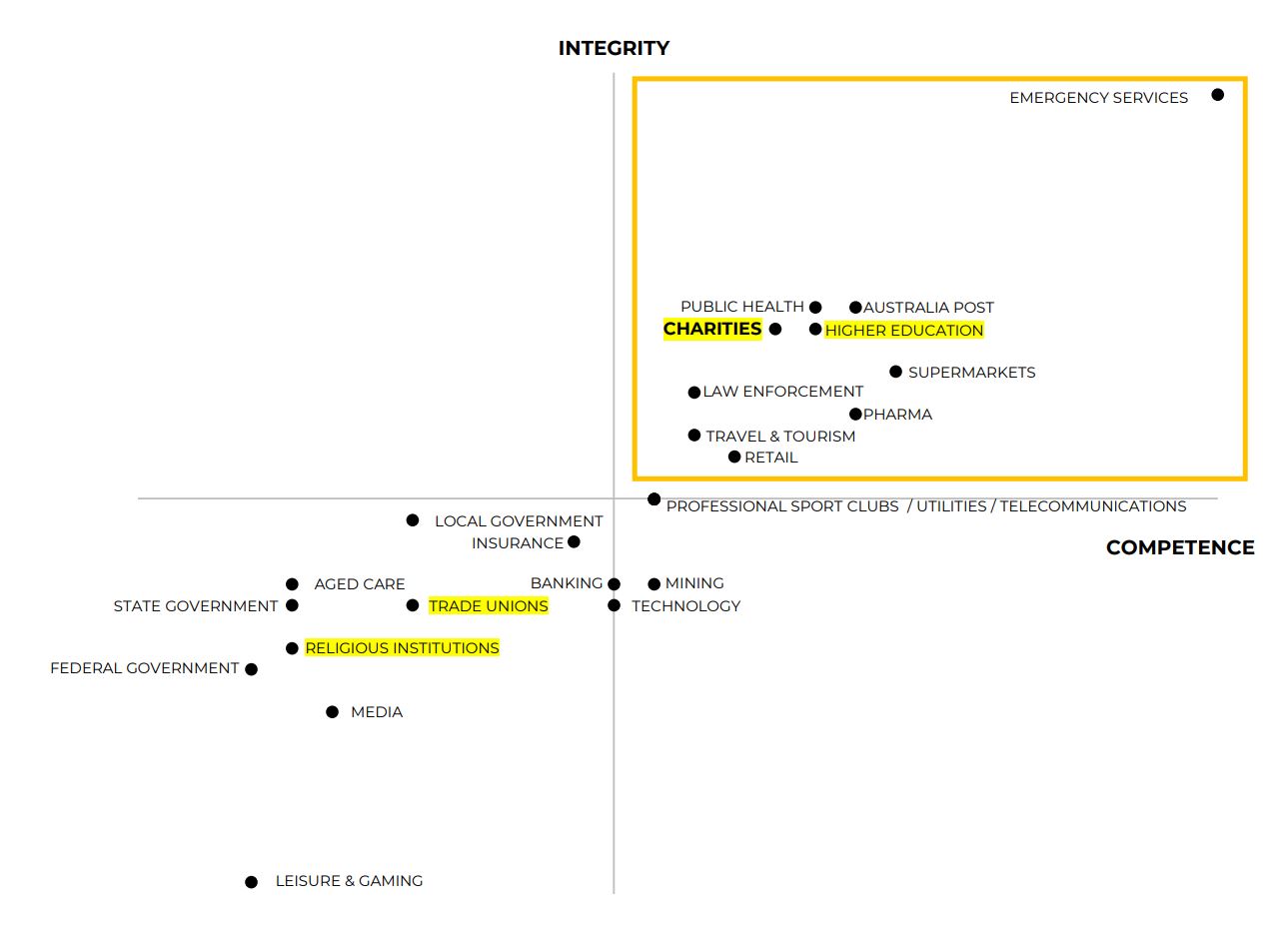HOW AUSTRALIANS VIEW THE INTEGRITY, COMPETENCE AND CONTRIBUTION OF CHARITIES - REPORT FOREWORD
Charities are at the heart of social ecosystems and play a vital role in building and sustaining flourishing communities. Yet, charities face several interlocking challenges that have only become more complex in a post-pandemic environment – one that has also been impacted by natural disasters.
In this context, charities are grappling with increased demand for services, financial sustainability, increasing job complexity, a declining volunteer workforce and the need to re-establish relationships with donors, all in the context of sustained impacts on the mental health, well-being and resilience of charity employees and leaders.
Ultimately, addressing these challenges is the work of leadership, requiring charity leaders to jointly orchestrate and create the enabling conditions to address these issues while sustaining the community goodwill and the social license to operate that charities have historically enjoyed.
What, then, is the current state of public perceptions of leadership in Australia’s charity sector? How does the charity sector compare to other institutions in the public, private and not-for-profit sectors, and what are the types of things that charity leaders can do to sustain public trust and confidence in charities?
Drawing on over twelve months of data collected by the Australian Leadership Index, this report shows how the public views the integrity, contribution, competence and leadership of the charity sector, revealing how the sector compares with national benchmarks, and offering fresh insights into the types of things that charity leaders can do to foster public trust in, and support of, the sector.

KEY FINDINGS
-
Charities Demonstrate Strong Leadership Performance
Charities are widely perceived as showing exemplary leadership for the greater good. Notably, charities perform significantly above the national benchmarks on all leadership metrics: overall leadership, leadership for the greater good, and public leadership.
-
Core Strengths: Integrity, Competence and Contribution
Charities perform strongly on all three drivers of leadership for the greater good: integrity, contribution and competence. The core strengths of charities include having a clear purpose for existence, their concern and care for the people in the community, and their contributions to improving the welfare of society.
-
Development Opportunities: Technological Innovation
Although charities perform well above the national benchmark for all three drivers of leadership for the greater good overall, charities perform significantly below the national benchmark in terms of public perceptions of technological leadership and innovation.

Sample details: These results are based a sample collected from October 2021 to December 2022, n = 745 (i.e., the number of observations from Australians about charitable
institutions) and n = 18,852 (i.e., the number of observations from Australians who rated any institution across the government, public, private and not-for-profit sectors).
CHARITIES OCCUPY AN ESTEEMED POSITION IN THE INSTITUTIONAL LANDSCAPE
-
In The Golden Quadrant: Charities Seen As High On Integrity And Competence
Charities are among a handful of institutions that are positioned in the ‘golden quadrant’. Institutions in this quadrant are viewed as having good intentions and the ability to enact these intentions; both major drivers of public trust.
-
Charities And Higher Education Are The Most Well Regarded Nonprofits
There is a striking contrast between charities and higher education institutions, which are trusted and esteemed by the public, and non-profit institutions like religious institutions and trade unions, which are distrusted.
-
Institutions In The Golden Quadrant Are Seen To Lead For The Greater Good
Notably, Australians look to institutions like charities to speak for and protect the public interest. This contrasts markedly with how the public views government institutions, which are seen to lack integrity and competence.

Sample details: These results are based on a nationally representative sample collected from October 2021 to December 2022 of n = 18,852 (i.e., the number of observations from Australians who rated any institution across the government, public, private and not-for-profit sectors), which equates to an average of 754 observations per institution.
Note. ‘‘Integrity’ refers to perceptions of accountability, honesty of intentions, and several other factors. Competence’ refers to perceptions of skill, efficiency, and several other factors.
About the report
Leadership for the greater good is relevant to all institutions and sectors, not just government institutions like the federal government or state governments. It is for this reason that the Australian Leadership Index (ALI) tracks a wide range of institutions across the government, public, private and not-for-profit sectors.
We measure and track key leadership metrics for twenty-five institutions across all sectors, including three government institutions, four public sector institutions, twelve private sector institutions (from retail through to mining), and four not-for-profit institutions. The ALI also measures two institutions the operate across sectors; namely, aged care institutions and professional sporting clubs and associations.
The ALI measures public perceptions of general categories of social institutions (e.g., ‘charities’) rather than specific organisations within a given category (e.g., The Australian Red Cross). This means that the results presented in this report relate to charities in general, not specific charitable organisations.
This report draws on survey results between October 2021 to December 2022, collecting data on each participant’s perceptions of leadership in the charities sector across that time period for each of the ALI’s metrics.



